Multi-Mission Oriented Joint Optimization of Task Assignment and Flight Path Planning for Heterogeneous UAV Cluster
Abstract
:1. Introduction
1.1. Research Background
1.2. Research Motivation
1.3. Organization
2. System Model
- There are numerous tasks with complex requirements, and these requirements vary for different tasks. This article highlights that the value gains achieved by the same UAV when performing different tasks also differ;
- In this article, it is highlighted that there is a wide range of UAVs available, each with different types and capabilities of mounted resources. As a result, when performing the same task, different UAVs can achieve varying value gains due to the constraints imposed by their payloads. It is worth noting that a UAV has the potential to participate in multiple tasks, and this collection of tasks is referred to as a task set;
- The task encompasses a vast geographical area, with multiple departure locations (ground stations), and each station allocates varying amounts of resources for UAV platforms. When it comes to UAVs undertaking long-range tasks, the distance traveled to reach the task area becomes a crucial factor that cannot be overlooked.
2.1. Constraint Model
2.1.1. Payload Constraint
2.1.2. Range Constraint
2.1.3. Task Requirement Constraint
2.2. Environment Model
2.2.1. Passive Threat
2.2.2. Active Threat
2.2.3. Threat Mapping
2.3. Solution Evaluation Model
- 1.
- Cost of the range:
- 2.
- Cost of the threat:
- 3.
- Total value gain: Considering the varying importance levels of tasks, the gains achieved upon their completion also differ. Hence, this section introduces the concept of “value gain” and provides the formula for its calculation:
3. Multi-Mission Oriented Joint Optimization of Task Assignment and Flight Path Planning for Heterogeneous UAV Cluster
3.1. Optimization Modeling Establishing
3.2. Optimization Model Solving
3.2.1. RWS Principle
3.2.2. Pheromone Update Rules
3.2.3. Improved ACO
- Initialization parameters: At the beginning of the calculation, relevant parameters need to be initialized, such as ant scale , information heuristic factor , expectation heuristic factor , information volatility factor , pheromone enhancement factor , and maximum number of iterations .
- Constructing the solution space: Each ant is placed in a different initial position, and the next node each ant will access is calculated according to Equation (17) until all nodes have been accessed by the ants.
- Update pheromones: The length of each ant’s path is calculated, and the optimal solution in the current iteration count is recorded. Simultaneously, the pheromone concentration on the connecting paths of each node is updated according to Equation (14).
- Judging whether to terminate: If the number of iterations is less than , the path record table of the ants is cleared and the process returns to step 2. Otherwise, the calculation is terminated and the optimal solution is output.
4. Simulation Results and Analysis
4.1. Simulation Parameter Setting
4.2. Simulation Results and Analysis
- Scenario 1: The threat source is solely composed of fixed obstacles.
- Scenario 2: The threat source comprises fixed obstacles and an anti-aircraft gun.
- Scenario 3: The threat includes fixed obstacles, an anti-aircraft gun, radar 1, and radar 2.
- Task assignment algorithm: Tasks are assigned to UAVs under various constraints to accomplish the overall mission. Subsequently, the results of task assignment are used as inputs for flight path planning, ignoring the coupling between the two.
- Trajectory planning algorithm: A feasible path is generated under the satisfaction of internal or external constraints such as minimum turning radius, minimum trajectory segment length, and environmental variables. Unlike the task assignment algorithm, it does not thoroughly consider value-gains-related matters.
- In Scenario 1, the heterogeneous UAV cluster completed all tasks using the task assignment algorithm. However, UAV1 and UAV4 in the cluster were not assigned any tasks, while UAV2 and UAV3 were assigned two tasks each. Conversely, using the trajectory planning algorithm, the cluster completed all tasks and assigned each UAV a task;
- In Scenario 2, the heterogeneous UAV cluster completed all tasks using the task assignment algorithm, but UAV4 in the cluster was not assigned any tasks, while UAV2 was assigned two tasks. In the same scenario, the cluster completed all tasks and assigned each UAV a task using the trajectory planning algorithm;
- In Scenario 3, the heterogeneous UAV cluster completed all tasks using the task assignment algorithm, but UAV1 and UAV6 in the cluster were not assigned any tasks, while UAV2 and UAV3 were assigned two tasks each. In the same scenario, the cluster also completed all tasks using the trajectory planning algorithm, but UAV5 was not assigned a specific task, while UAV4 was assigned two tasks.
- The targeted consolidated cost of the algorithm proposed in this paper is higher than that of the other two algorithms in the three scenarios, corroborating that the algorithm can fully leverage the UAV resources and enhance the effectiveness of cluster combat. This indicates that the algorithm introduced in this study offers distinct advantages in addressing issues related to task assignment and joint flight path planning optimization;
- The targeted consolidated cost of the task assignment algorithm is more expensive than that of the trajectory planning algorithm in each scenario. Given the environment established in this study, the task assignment algorithm proves more beneficial than the trajectory planning algorithm;
- An upward trend is observed in the targeted consolidated value of all three algorithms as the complexity of the scenario increases. This suggests that the environment significantly influences all three algorithms.
5. Conclusions
Author Contributions
Funding
Conflicts of Interest
Abbreviations
| UAV | unmanned aerial vehicle |
| MMS | multi-mission scenario |
| RWS | roulette wheel selection |
| ES | elite strategy |
| ACO | ant colony optimization |
References
- Fan, B.; Li, Y.; Zhang, R.; Fu, Q. Review on the technological development and application of UAV systems. Chin. J. Electron. 2020, 29, 199–207. [Google Scholar] [CrossRef]
- Qi, X.; Li, B.; Fan, Y.; Liu, F. A survey of mission planning on UAVs systems based on multiple constraints. CAAI Trans. Intell. Syst. 2020, 15, 204–217. [Google Scholar]
- Brahmi, I.; Koubaa, H.; Zarai, F. Genetic algorithm based resource allocation for V2X communications. In Proceedings of the 2020 IEEE Eighth International Conference on Communications and Networking (ComNet), Virtual Event, 28–30 October 2020; pp. 1–5. [Google Scholar]
- Xia, W.; Quek, T.Q.; Zhang, J.; Jin, S.; Zhu, H. Programmable hierarchical C-RAN: From task scheduling to resource allocation. IEEE Trans. Wirel. Commun. 2019, 18, 2003–2016. [Google Scholar] [CrossRef]
- Li, J.; Xiong, Y.H.; She, J.H. UAV path planning for target coverage task in dynamic environment. IEEE Internet Things J. 2023, 10, 17734–17745. [Google Scholar] [CrossRef]
- Zhai, S.; Li, G.; Wu, G.; Hou, M.; Jia, Q. Cooperative task allocation for multi heterogeneous aerial vehicles using particle swarm optimization algorithm and entropy weight method. Appl. Soft Comput. 2023, 148, 110918. [Google Scholar] [CrossRef]
- Ponda, S.S.; Johnson, L.B.; Geramifard, A.; How, J.P. Cooperative Mission Planning for Multi-UAV Teams; Springer: Dordrecht, The Netherlands, 2015. [Google Scholar]
- Hu, J.; Wu, H.; Zhan, R.; Menassel, R.; Zhou, X. Self-organized search-attack mission planning for UAV swarm based on wolf pack hunting behavior. J. Syst. Eng. Electron. 2021, 32, 1463–1476. [Google Scholar]
- Du, Y.; Xing, L.; Cai, Z. A review of intelligent scheduling technology for unmanned aerial vehicle clusters. J. Autom. 2020, 46, 222–241. [Google Scholar]
- Bays, M.J.; Wettergren, T.A. Service agent-transport agent task planning incorporating robust scheduling techniques. Robot. Auton. Syst. 2017, 89, 15–26. [Google Scholar] [CrossRef]
- Chen, H.; Wang, X.R.; Shen, L.C.; Cong, Y.R. Formation flight of fixed-wing UAV swarms: A group-based hierarchical approach. Chin. J. Aeronaut. 2021, 34, 504–515. [Google Scholar] [CrossRef]
- Wu, W.; Wang, X.; Cui, N. Fast and coupled solution for cooperative mission planning of multiple heterogeneous unmanned aerial vehicles. Aerosp. Sci. Technol. 2018, 79, 131–144. [Google Scholar] [CrossRef]
- Wang, R.; Wei, W.; Yang, M. Multi-UAV task assignment considering collaborative route planning. J. Aeronaut. Astronaut. 2020, 41, 24–35. [Google Scholar]
- Amorim, J.C.; Alves, V.; Freitas, E.P.D. Assessing a swarm-GAP based solution for the task allocation problem in dynamic scenarios. Expert Syst. Appl. 2020, 152, 113437. [Google Scholar] [CrossRef]
- Wang, J.F.; Jia, G.W.; Xin, H.B.; Hon, Z.X. Research on dynamic task allocation method of heterogeneous multi-UAV based on consensus based bundle algorithm. In Proceedings of the 2020 Chinese Automation Congress (CAC), Shanghai, China, 6–8 November 2020; pp. 2214–2219. [Google Scholar]
- Sun, D.; Li, M. Evaluation function optimization of A-Star algorithm in optimal Path Selection. Rev. Téc. Ing. Univ. 2016, 39, 105–111. [Google Scholar]
- Xu, X.; Wang, M.; Dong, Y. Mobile robot path planning based on improved artificial potential field method. Comput. Appl. 2020, 40, 3508–3512. [Google Scholar]
- Zhang, H.; Wang, Y.; Zheng, J.; Yu, J. Path planning of industrial robot based on improved RRT algorithm in complex environments. IEEE Access 2018, 6, 53296–53306. [Google Scholar] [CrossRef]
- Mesquita, R.; Gaspar, P.D. A novel path planning optimization algorithm based on particle swarm optimization for UAVs for bird monitoring and repelling—Simulation results. In Proceedings of the 2020 International Conference on Decision Aid Sciences and Application (DASA), Sakheer, Bahrain, 8–9 November 2020. [Google Scholar]
- Wang, X.; Fang, H.; Guo, L. A study on cooperative trajectory planning of multiple UAVs under unexpected threat environment based on improved ant colony algorithm. J. Zhengzhou Aviat. Ind. Manag. Coll. 2023, 41, 79–86. [Google Scholar]
- Chen, H.; Cong, Y.R.; Wang, X.K.; Xu, X.; Shen, L.C. Coordinated Path-Following Control of Fixed-Wing Unmanned Aerial Vehicles. IEEE Trans. Syst. Man Cybern. Syst. 2022, 52, 2540–2554. [Google Scholar] [CrossRef]
- Albani, D.; Nardi, D.; Honig, W. Summary: Distributed task assignment and path planning with limited communication for robot teams. Adapt. Agents Multiagent Syst. 2019, 5, 13–17. [Google Scholar]
- Kim, M.L.S. Resource welfare based task allocation for UAV team with resource constraints. J. Intell. Robot. Syst. Theory Appl. 2015, 77, 611–627. [Google Scholar] [CrossRef]
- Cui, N.; Wu, W.; Guo, J. Integrated distributed method for dynamic cooperative mission planning problem. Chin. J. Inert. Technol. 2017, 25, 523–529. [Google Scholar]
- Yan, M.; Yuan, H.; Xu, J.; Yu, Y.; Jin, L. Task allocation and route planning of multiple UAVs in a marine environment based on an improved particle swarm optimization algorithm. Eurasip. J. Adv. Signal Process. 2021, 2021, 94. [Google Scholar] [CrossRef]
- Shorakaei, H.; Vahdani, M.; Imani, B.; Gholami, A. Optimal cooperative path planning of unmanned aerial vehicles by a parallel genetic algorithm. Robotica 2016, 34, 823–836. [Google Scholar] [CrossRef]
- Luo, J.; Wang, Z.; Zuo, Z.; Deng, P. Research on dynamic task planning of UAV based on ant colony algorithm. In Proceedings of the 2019 IEEE 9th Annual International Conference on CYBER Technology in Automation, Control, and Intelligent Systems (CYBER), Suzhou, China, 29 July–2 August 2019; pp. 1515–1519. [Google Scholar]
- Liu, W.; Zhu, J. Research on aircraft trajectory planning based on ant colony algorithm. J. Harbin Univ. Commer. 2020, 36, 012029. [Google Scholar]
- Sun, Y.; Chen, H.; Ren, C. Application of ant colony algorithm based on elite strategy in AGV path optimization. Logist. Eng. Manag. 2022, 44, 30–32. [Google Scholar]
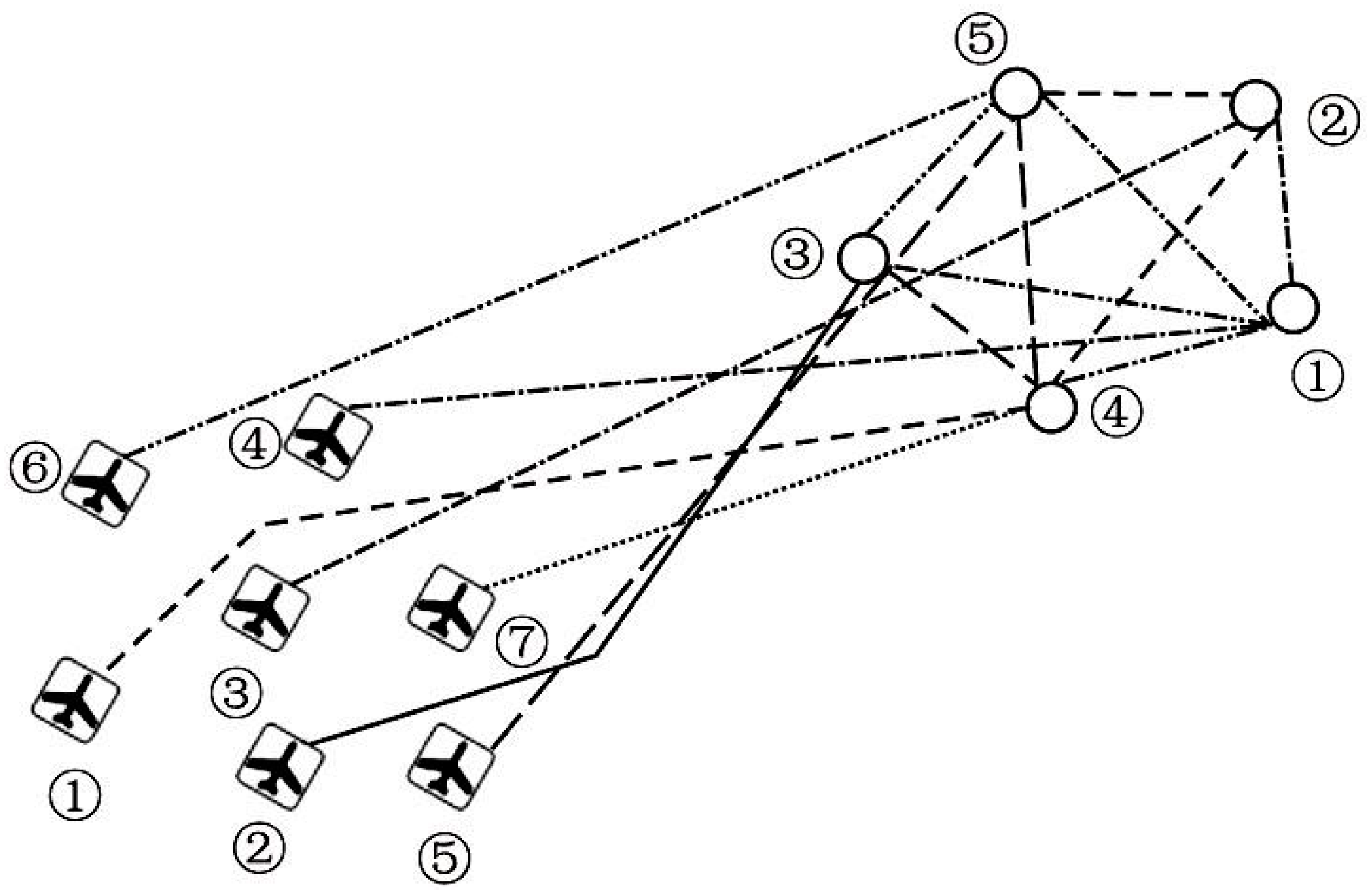


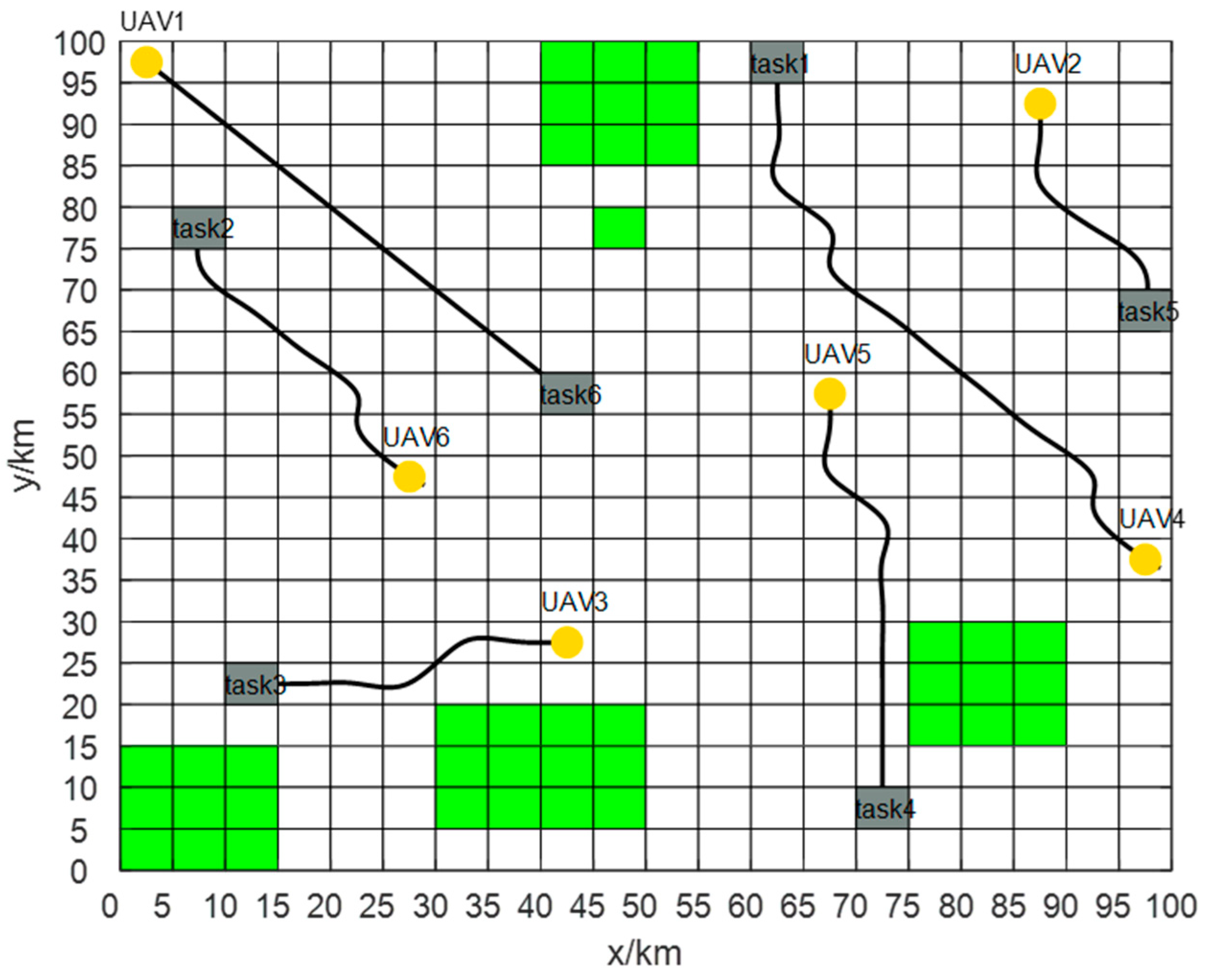
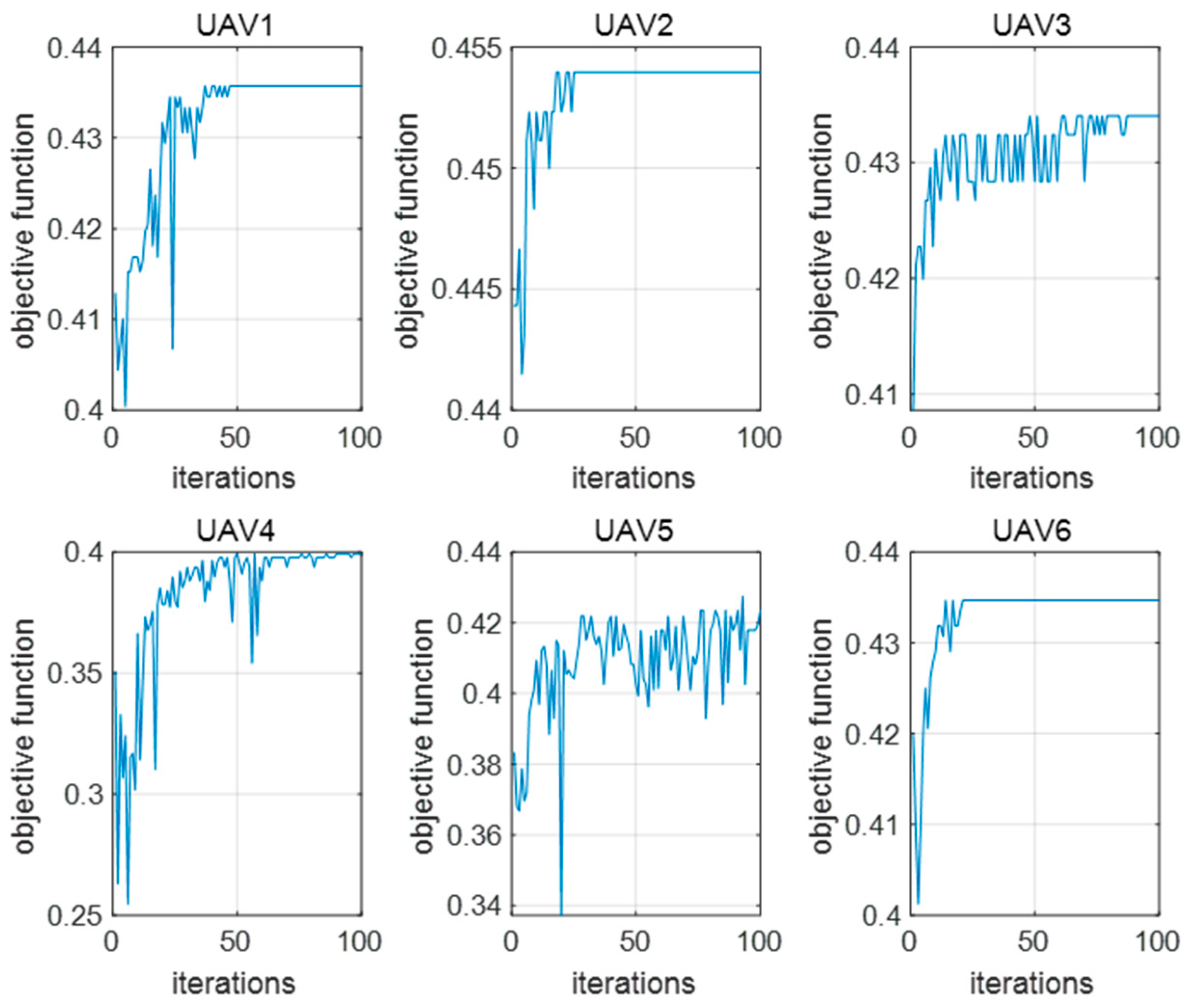
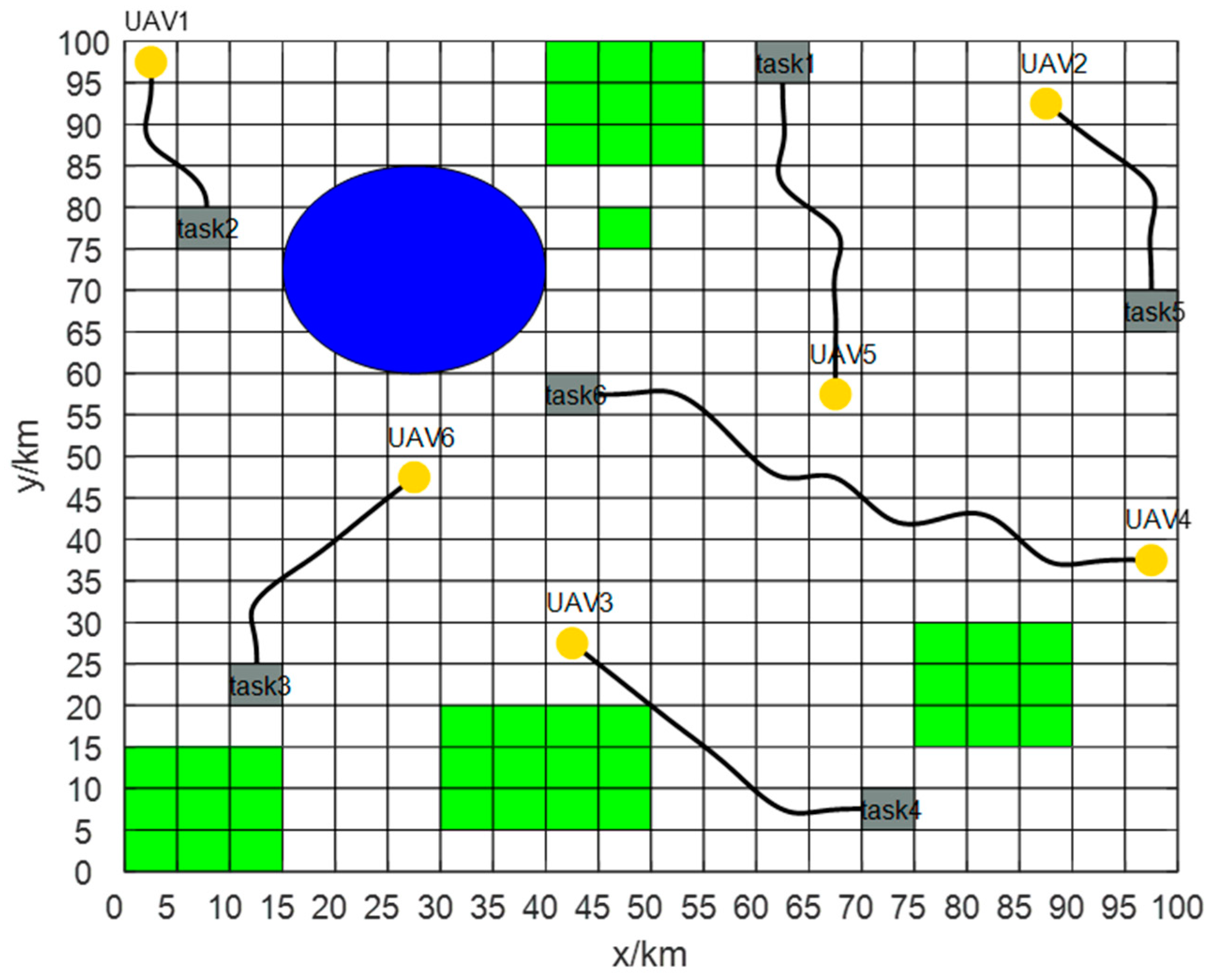

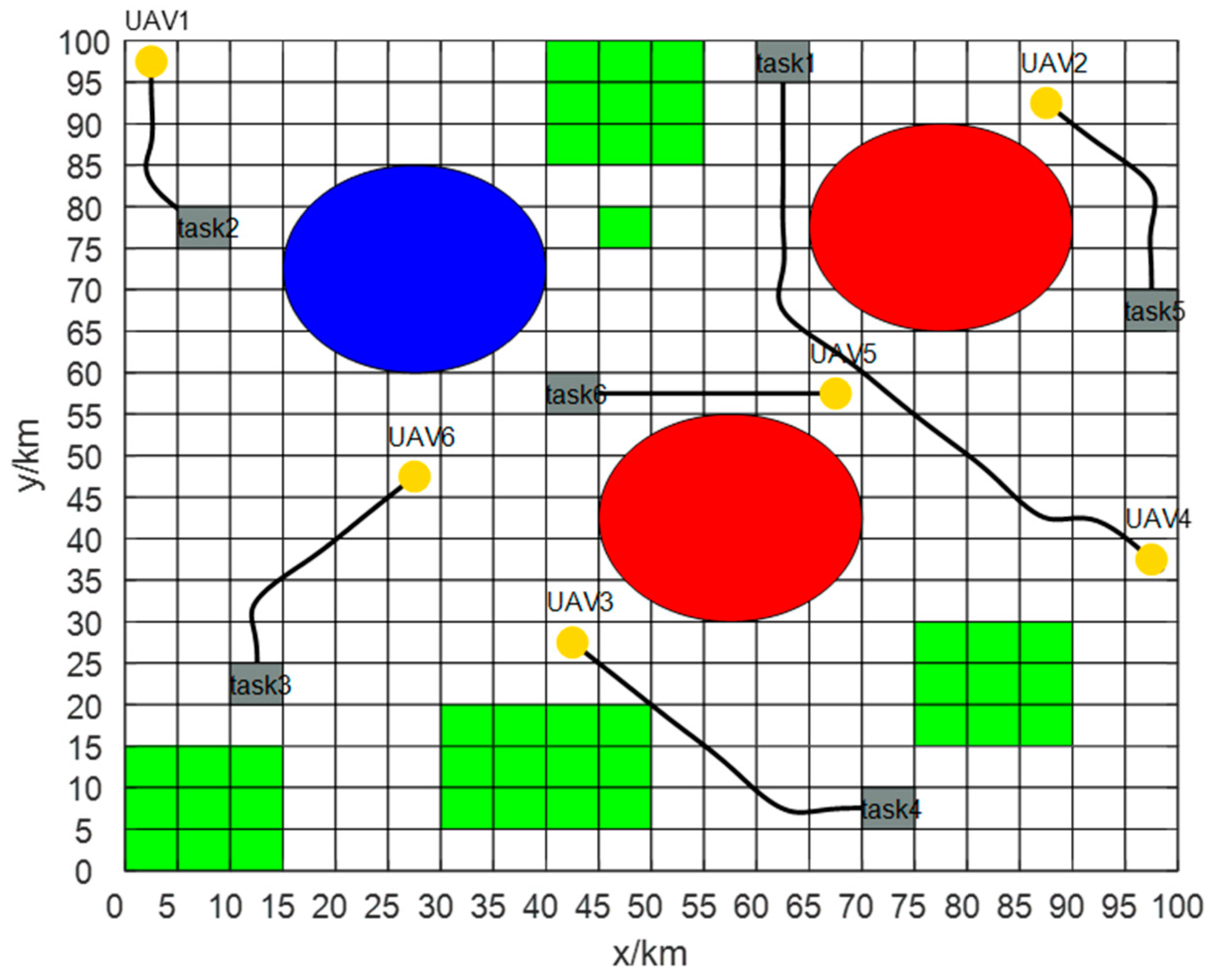
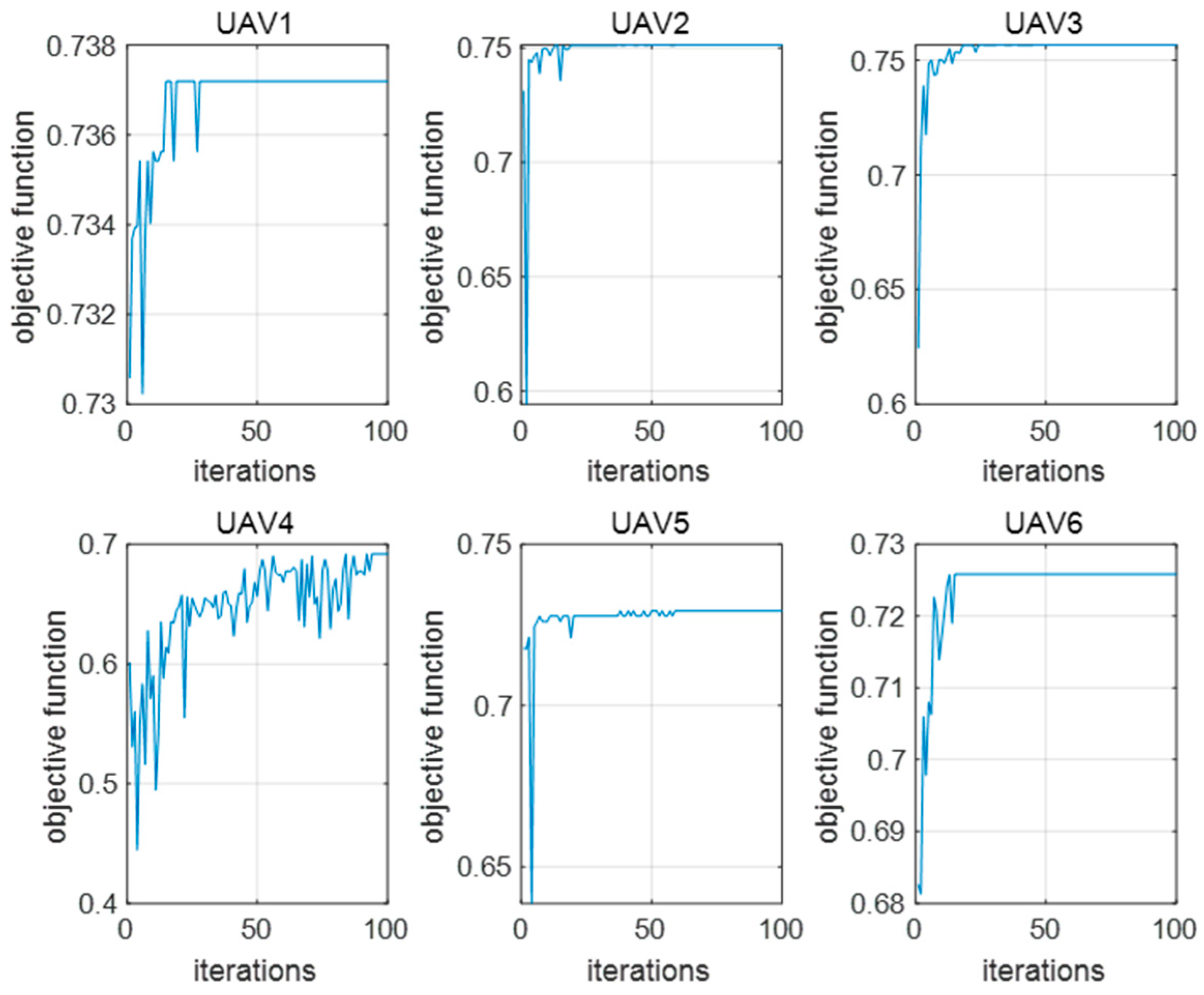
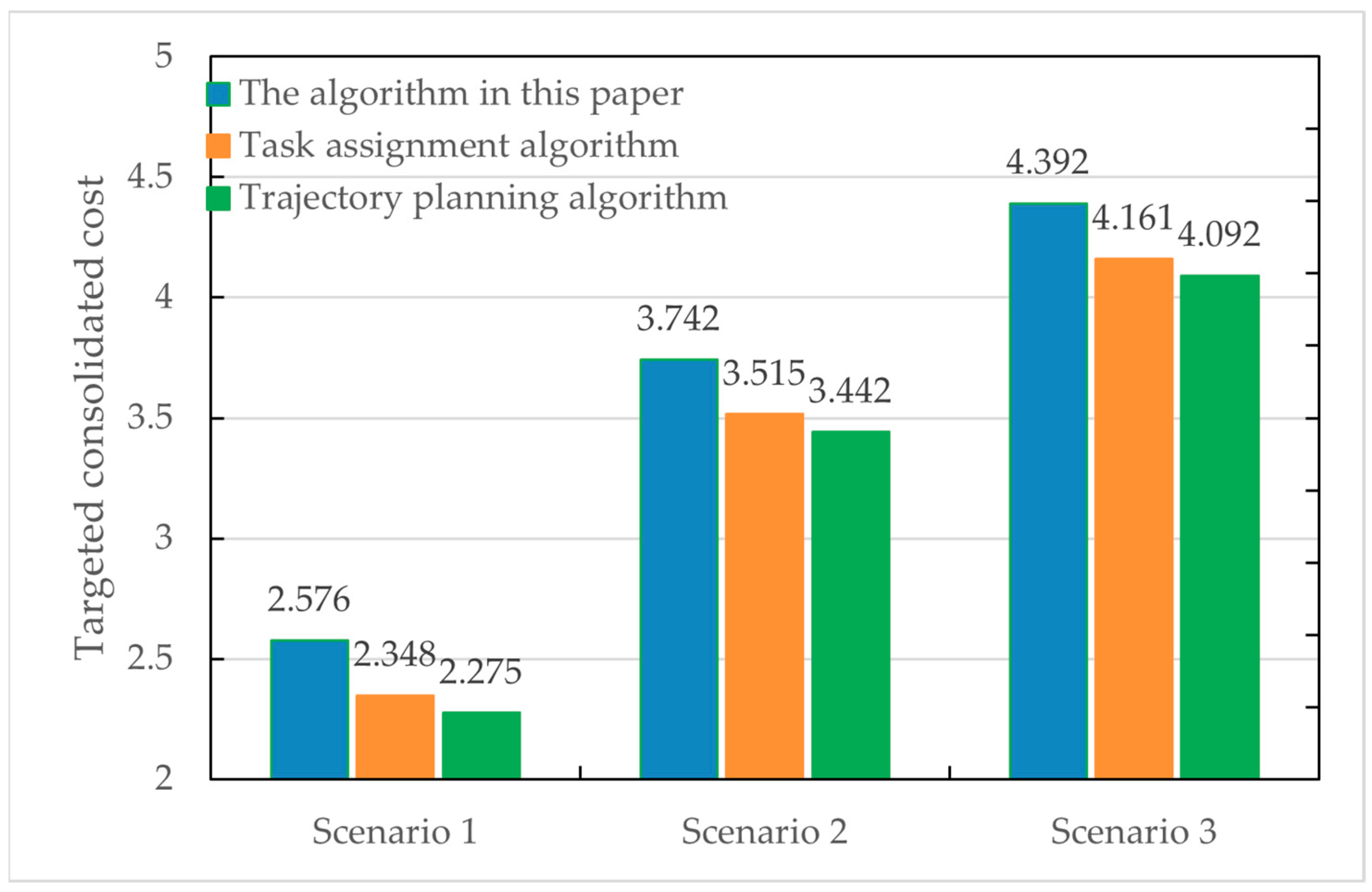
| Parameters | Notation | Value |
|---|---|---|
| Number of ants | 40 | |
| Maximum number of iterations | 100 | |
| Information heuristic factor | 1 | |
| Expectation heuristic factor | 7 | |
| Information evaporation factor | 0.3 | |
| Pheromone enhancement factor | 1 |
| UAV No. | Placement (km) | Value Gains | Maximum Range (km) | Payload |
|---|---|---|---|---|
| 1 | (2.5, 97.5) | 8 | 200 | 3 |
| 2 | (87.5, 92.5) | 7 | 200 | 5 |
| 3 | (42.5, 27.5) | 9 | 200 | 4 |
| 4 | (97.5, 37.5) | 7 | 200 | 3 |
| 5 | (67.5, 57.5) | 6 | 200 | 5 |
| 6 | (27.5, 47.5) | 8 | 200 | 4 |
| Task No. | Placement (km) | Value Gains |
|---|---|---|
| 1 | (62.5, 97.5) | 4 |
| 2 | (7.5, 77.5) | 6 |
| 3 | (12.5, 22.5) | 5 |
| 4 | (72.5, 7.5) | 8 |
| 5 | (97.5, 67.5) | 9 |
| 6 | (42.5, 57.5) | 7 |
| Threat | Vertex 1 (km) | Vertex 2 (km) | Vertex 3 (km) | Vertex 4 (km) |
|---|---|---|---|---|
| Threat 1 | (0, 0) | (0, 15) | (15, 0) | (15, 15) |
| Threat 2 | (45, 75) | (45, 80) | (50, 75) | (50, 80) |
| Threat 3 | (30, 5) | (30, 20) | (50, 5) | (50, 20) |
| Threat 4 | (75, 15) | (75, 30) | (90, 15) | (90, 30) |
| Threat 5 | (45, 85) | (45, 100) | (55, 85) | (55, 100) |
| Threat | Placement (km) | Radius of Action (km) |
|---|---|---|
| Radar 1 | (57.5, 42.5) | 2.5 |
| Radar 2 | (77.5, 77.5) | 2.5 |
| Anti-aircraft gun | (27.5, 72.5) | 2.5 |
| UAV No. | Task Assignment Algorithm | Trajectory Planning Algorithm |
|---|---|---|
| 1 | — | Task2 |
| 2 | Task5→Task6 | Task1 |
| 3 | Task3→Task2 | Task3 |
| 4 | — | Task4 |
| 5 | Task4 | Task5 |
| 6 | Task1 | Task6 |
| UAV No. | Task Assignment Algorithm | Trajectory Planning Algorithm |
|---|---|---|
| 1 | Task2 | Task2 |
| 2 | Task5→Task6 | Task5 |
| 3 | Task3 | Task4 |
| 4 | — | Task1 |
| 5 | Task4 | Task6 |
| 6 | Task1 | Task3 |
| UAV No. | Task Assignment Algorithm | Trajectory Planning Algorithm |
|---|---|---|
| 1 | — | Task2 |
| 2 | Task1→Task6 | Task5 |
| 3 | Task3→Task2 | Task4 |
| 4 | Task5 | Task6→Task1 |
| 5 | Task4 | — |
| 6 | — | Task3 |
Disclaimer/Publisher’s Note: The statements, opinions and data contained in all publications are solely those of the individual author(s) and contributor(s) and not of MDPI and/or the editor(s). MDPI and/or the editor(s) disclaim responsibility for any injury to people or property resulting from any ideas, methods, instructions or products referred to in the content. |
© 2023 by the authors. Licensee MDPI, Basel, Switzerland. This article is an open access article distributed under the terms and conditions of the Creative Commons Attribution (CC BY) license (https://creativecommons.org/licenses/by/4.0/).
Share and Cite
Dong, X.; Shi, C.; Wen, W.; Zhou, J. Multi-Mission Oriented Joint Optimization of Task Assignment and Flight Path Planning for Heterogeneous UAV Cluster. Remote Sens. 2023, 15, 5315. https://doi.org/10.3390/rs15225315
Dong X, Shi C, Wen W, Zhou J. Multi-Mission Oriented Joint Optimization of Task Assignment and Flight Path Planning for Heterogeneous UAV Cluster. Remote Sensing. 2023; 15(22):5315. https://doi.org/10.3390/rs15225315
Chicago/Turabian StyleDong, Xili, Chenguang Shi, Wen Wen, and Jianjiang Zhou. 2023. "Multi-Mission Oriented Joint Optimization of Task Assignment and Flight Path Planning for Heterogeneous UAV Cluster" Remote Sensing 15, no. 22: 5315. https://doi.org/10.3390/rs15225315
APA StyleDong, X., Shi, C., Wen, W., & Zhou, J. (2023). Multi-Mission Oriented Joint Optimization of Task Assignment and Flight Path Planning for Heterogeneous UAV Cluster. Remote Sensing, 15(22), 5315. https://doi.org/10.3390/rs15225315






